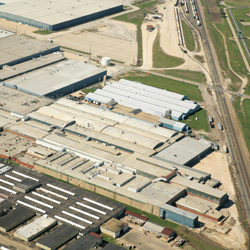
When Maytag moved its manufacturing operations to Mexico, the city of Galesburg was left with a devastating hole in its economy. One study looks to analyze how the community has fared since.
When Maytag announced that it would close its Galesburg plant in 2004, the central Illinois community was demoralized. The plant, which had been in operation under various owners since 1905, was one of the community’s major employers, with nearly 8,000 workers on the payroll in its heyday. By the time the plant closed, however, those numbers had been whittled down to about 1,600 union workers and a number of management workers.
With so many people forced out of their jobs, both the employees and the city itself entered a state of dejection. Not only were individual workers affected, but likewise the city, which had offered economic incentives for several years; Galesburg schools; and local nonprofit and community organizations, which had received sponsorships from the company.
“[Maytag] left exactly at the point when the incentives ran out,” reported Marilyn Webb, chair of the journalism department at Knox College, which headed up the study on the closure. “So for one thing, the city felt gypped, betrayed, that the loyalty they had given to come up with money to keep this factory here—in a poor community—that they had used up what they needed to and then left.”
Many of the now-unemployed employees could no longer afford the lifestyles to which they had been accustomed, affecting everything from restaurants to clothing stores. Many of the local suppliers who existed because of the business brought in by Maytag were forced to scale back tremendously or shut down entirely. Worries that housing prices would plummet as thousands moved away in search of jobs were prevalent. “There was this Rust Belt thought that ‘The last one out, turn out the lights,’” reported Webb. “But that didn’t happen.”
Many workers gained hope from the retraining benefits to which they were entitled under 1994’s North American Free Trade Agreement. NAFTA allowed workers who were left unemployed by companies that moved their operations out of the country to be retrained in high-growth industries. Between 500 and 600 former Maytag employees took advantage of these benefits, earned degrees or certificates, and entered new careers.
 The Community’s Reaction
The Community’s Reaction
In the wake of this monumental change, the community wanted to know what had happened to itself. Former factory workers wondered what had become of their peers, the people of Galesburg were interested in how flexible its workforce was, and those involved in the retraining process at Carl Sandburg College wanted to know how successful their program was.
In 2008, a Knox College alum gifted a building to the journalism department, in addition to a monetary gift the department could use for whatever research it wanted. The faculty got together and decided to use it to help answer the questions that had come about after the closing of the Maytag plant. “We all have been told this story of a post-industrial economy happening,” explained Webb, “and we wondered what does that mean—especially here in the Midwest, where a lot of factory closures have happened over the last 20 or 30 years?”
Knox journalism students had covered the closure of the plant and had their work published in the local paper. Especially attuned to the story, one of Webb’s classes profiled nine of the former Maytag workers, after which the workers helped develop survey questions that would be sent to their peers, accompanied by a cover letter from the former union president asking for their participation. The surveys would be used to help answer the community’s questions.
After overcoming the challenge of tracking down workers who had moved away and writing pointed questions that would produce the desired information, the surveys were mailed to 425 people. The response rate was 31 percent, noted Webb, considered to be a “pretty good” rate and in line with similar surveys.
“When I went into this, I thought that everybody would have a sob story,” she admitted. “In fact, the people who we’ve seen are much more resilient than that. There are some sad stories, but many of the [former Maytag workers] have really adapted successfully, and some are even glad the plant closed because it changed their lives in a positive way. That said, there’s a lot of anger, still, about Maytag leaving.”
Part of the heartbreak comes from the feeling that Maytag used up the resources provided to it and quickly took its business to Mexico where labor was much cheaper. But part of it, too, comes from the pride that workers felt in their work at the plant. “In 1998, Consumer Reports rated this particular refrigerator, and in particular, this plant’s production, as among the best in the country,” said Webb. “They were very proud of the product they were producing and felt really betrayed by having it move somewhere where cheap labor was really all that mattered to this company that they had given so much to.”
The survey found that workers’ life satisfaction levels correlated strongly with their level of satisfaction while on the job. Those who enjoyed what they did at Maytag felt they had lost a sense of identity and were more depressed than those who hadn’t been as attached to their jobs.
 Entertaining New Opportunities
Entertaining New Opportunities
In any case, those who adapted best to the closing were the workers who took advantage of retraining and entered new careers. Under NAFTA, workers could choose to enter fields that had been designated as “high-growth,” but because those fields were based on national data, not all of the high-growth fields were high-growth here. For instance, there weren’t many mortuary science or horticulture jobs available in central Illinois, although some had chosen to enter those industries. “Certain people ended up doing better after training, and certain people didn’t,” explained Webb.
There seemed to be two groups of people—those who are still devastated by the plant’s closing because they haven’t been able to find new jobs, and those who believe the closing was the best thing that ever happened to them, as they would not have gone back to school and started new careers otherwise. “And because they went back to college,” said Webb, “it changed their concept of self.”
Melissa Bowling and Christine Britton worked on the production line at the Maytag plant—Bowling for 10 years and Britton for 15—and both took advantage of the opportunity to retrain. Bowling went into mechanical drawing and now designs fire trucks for Alexis Fire Equipment Company.
Webb reports that Bowling’s view is a positive one—she was able to graduate from high school and get a decent job in the factory at a young age, but didn’t realize how much she could grow by leaving the plant until she was forced to do so. “She’s just changed tremendously because of her own sense of who she is and what she can do,” said Webb.
Britton went back to school after the plant closed, obtained a nursing degree, and now works in the newborn unit at Cottage Hospital in Galesburg. She feels that what she does now matters tremendously more than what she did at the factory, and she’s making quite a bit more money, too, as is Bowling.
“On the other hand,” said Webb, “there are people who are just completely depressed and unemployed, still.” She notes that women seemed to have adapted better to losing their jobs at Maytag, having gone through the retraining process and gotten new jobs. Most of the men who were retrained went into other blue-collar jobs, such as truck driving, whereas most of the women entered jobs that were either white- or “pink-collar,” like selling medical equipment or working with computers.
Some of the workers were eligible for retirement when the plant shut down, although many who took pensions soon found that their benefits weren’t enough to maintain their quality of life. Other workers got jobs at Caterpillar in Peoria and John Deere in the Quad Cities, setting up carpools to save money on travel expenses. Still others were retrained and hired by Burlington Northern Santa Fe Railroad in Galesburg, now one of the city’s largest employers.
“The resiliency of the American worker is astounding,” offered Webb. Having anticipated primarily negative results to the surveys, she found the reality to be much more positive. “There’s a sense of wanting to tell their stories to someone who wants to listen, because it’s been so powerful for them, but there’s also a sense that they feel they’re contributing to history.” iBi

